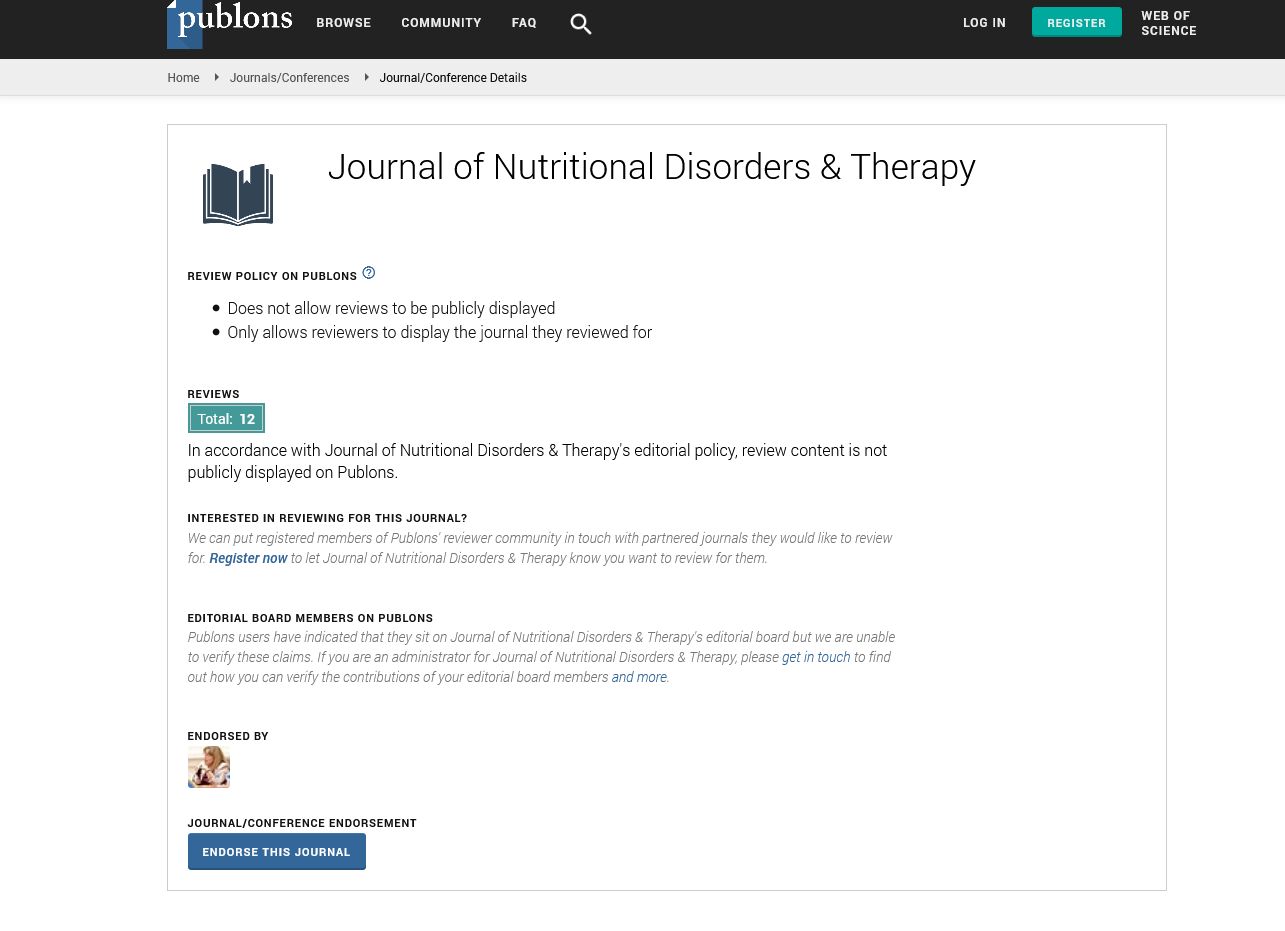Indexed In
- Open J Gate
- Genamics JournalSeek
- Academic Keys
- JournalTOCs
- Ulrich's Periodicals Directory
- RefSeek
- Hamdard University
- EBSCO A-Z
- OCLC- WorldCat
- Publons
- Geneva Foundation for Medical Education and Research
- Euro Pub
Useful Links
Share This Page
Journal Flyer

Open Access Journals
- Agri and Aquaculture
- Biochemistry
- Bioinformatics & Systems Biology
- Business & Management
- Chemistry
- Clinical Sciences
- Engineering
- Food & Nutrition
- General Science
- Genetics & Molecular Biology
- Immunology & Microbiology
- Medical Sciences
- Neuroscience & Psychology
- Nursing & Health Care
- Pharmaceutical Sciences
Perspective - (2024) Volume 14, Issue 4
The Impact of ENPP1 Deficiency in ARHR2 on Bone Mineral Metabolism: Implications for Nutritional Therapy
Jakob Kornak*Received: 22-Nov-2024, Manuscript No. JNDT-24-27634; Editor assigned: 25-Nov-2024, Pre QC No. JNDT-24-27634(PQ); Reviewed: 09-Dec-2024, QC No. JNDT-24-27634; Revised: 16-Dec-2024, Manuscript No. JNDT-24-27634(R); Published: 23-Dec-2024, DOI: 10.35248/2161-0509.24.14.313
Description
Autosomal Recessive Hypophosphatemic Rickets Type 2 (ARHR2) is a rare genetic disorder characterized by impaired phosphate homeostasis, leading to defective bone mineralization and a variety of skeletal deformities. The condition, which is caused by mutations in the ENPP1 gene, presents early in childhood with symptoms that resemble other forms of rickets but is distinct in its underlying molecular mechanism. The role of ENPP1 (Ectonucleotide Pyrophosphatase/Phosphodiesterase 1) in phosphate regulation and bone mineralization has garnered increasing attention in recent years, particularly for its critical role in the pathophysiology of ARHR2. Understanding the genetic and biochemical basis of this disease offers insights into potential diagnostic strategies and therapeutic interventions.
ARHR2 is caused by mutations in the ENPP1 gene, which encodes the enzyme ectonucleotide pyrophosphatase/phosphodiesterase 1 This enzyme is involved in the regulation of extracellular Pyrophosphate (PPi), an important inhibitor of mineralization. PPi helps to prevent the pathological deposition of minerals in soft tissues and ensures that mineralization occurs properly in bone. Normally, ENPP1 helps to regulate the balance between phosphate and pyrophosphate in the extracellular matrix, a essential process for maintaining bone integrity.
In patients with ARHR2, mutations in the ENPP1 gene result in deficient or absent enzyme activity, leading to elevated levels of PPi. This disruption interferes with phosphate metabolism, resulting in hypophosphatemia (low phosphate levels) and defective bone mineralization. The low phosphate levels impair the mineralization of the bone matrix, causing the characteristic skeletal deformities seen in ARHR2, such as bowed legs, short stature and a softening of the bones.
The pathophysiology of ARHR2 is rooted in a disruption of phosphate regulation. Phosphate is essential for bone mineralization, as it combines with calcium to form hydroxyapatite, the mineral compound that gives bones their strength and rigidity. Inadequate phosphate levels due to ENPP1 deficiency prevent this process from occurring normally, resulting in the characteristic features of rickets, including skeletal deformities and delayed bone growth.
In addition to its role in bone mineralization, phosphate is involved in numerous biological processes, including energy metabolism, cell signaling and DNA synthesis. The inadequate levels of phosphate in ARHR2 affect not only the skeleton but also other tissues that depend on phosphate for normal function. While the skeletal abnormalities are the most prominent feature, patients may also experience growth retardation, dental abnormalities and other systemic complications.
Another important aspect of ARHR2 is the role of PPi, which inhibits the calcification of soft tissues. In the absence of functional ENPP1, the accumulation of PPi further exacerbates the issue of defective mineralization, contributing to the abnormal deposition of calcium in soft tissues such as the vasculature and kidneys. This can lead to the development of vascular and renal complications in some patients, although these are typically less pronounced than the skeletal manifestations.
The clinical presentation of ARHR2 typically appears in early childhood, with patients showing signs of bone deformities and growth failure. The most common skeletal abnormalities include bowed legs, which are caused by the softening of the bones and a flattened skull (craniotabes). Children with ARHR2 often have a short stature due to delayed bone growth and the bones may be tender or painful. In severe cases, patients may experience fractures or deformities in the spine, leading to difficulty walking or other mobility issues.
Other signs may include delayed motor milestones, as the softening of the bones and joint instability can impair movement and coordination. Many affected individuals also have dental abnormalities, such as delayed eruption of teeth and enamel hypoplasia, which are linked to phosphate deficiency. These features can vary in severity and the age of onset often depends on the specific mutation in the ENPP1 gene.
The diagnosis of ARHR2 is made based on clinical findings, biochemical tests and genetic analysis. Biochemically, patients with ARHR2 typically present with hypophosphatemia, low serum phosphate levels and elevated alkaline phosphatase levels, which is indicative of bone turnover. In contrast to other forms of rickets, ARHR2 is characterized by normal or even elevated levels of serum calcium and 25-hydroxyvitamin D. These findings help to distinguish ARHR2 from other causes of rickets, such as vitamin D deficiency or X-linked hypophosphatemic rickets.
Genetic testing is essential for confirming the diagnosis, as it allows for the identification of mutations in the ENPP1 gene. This can provide a definitive diagnosis and help to differentiate ARHR2 from other forms of rickets with similar clinical presentations. In addition, genetic counseling is important for affected families, as ARHR2 is inherited in an autosomal recessive manner, meaning both parents must carry a copy of the mutated gene for the condition to be expressed in their offspring.
Conclusion
Autosomal Recessive Hypophosphatemic Rickets type 2 (ARHR2), caused by ENPP1 deficiency, is a rare but clinically significant disorder that disrupts phosphate metabolism and leads to defective bone mineralization. While vitamin D plays a wellknown role in bone health, ARHR2 highlights the critical importance of phosphate regulation in maintaining bone integrity. Early diagnosis through biochemical testing and genetic analysis, along with appropriate phosphate supplementation, is essential for managing this condition and preventing further complications.
Citation: Kornak J (2024). The Impact of ENPP1 Deficiency in ARHR2 on Bone Mineral Metabolism: Implications for Nutritional Therapy. J Nutr Disord Ther. 14:313.
Copyright: © 2024 Kornak J. This is an open-access article distributed under the terms of the Creative Commons Attribution License, which permits unrestricted use, distribution, and reproduction in any medium, provided the original author and source are credited.

